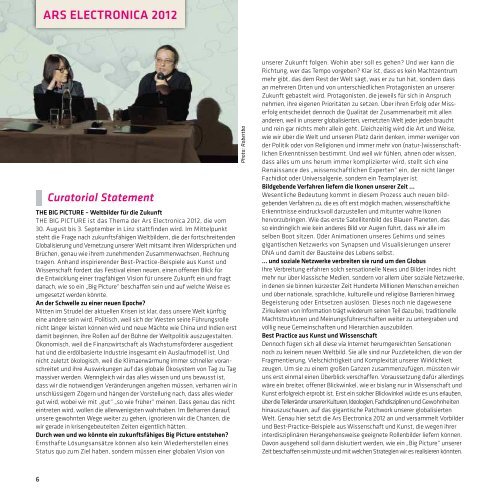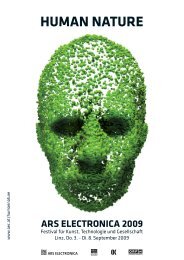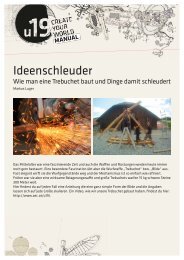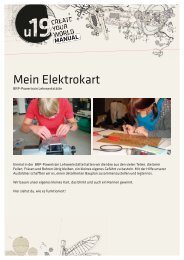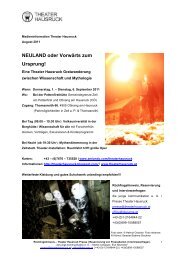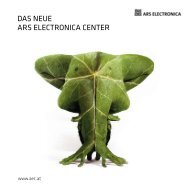festival - Ars Electronica Center
festival - Ars Electronica Center
festival - Ars Electronica Center
Sie wollen auch ein ePaper? Erhöhen Sie die Reichweite Ihrer Titel.
YUMPU macht aus Druck-PDFs automatisch weboptimierte ePaper, die Google liebt.
6<br />
ARS ELECTRONICA 2012<br />
Curatorial Statement<br />
THE BIG PICTURE – Weltbilder für die Zukunft<br />
THE BIG PICTURE ist das Thema der <strong>Ars</strong> <strong>Electronica</strong> 2012, die vom<br />
30. August bis 3. September in Linz stattfinden wird. Im Mittelpunkt<br />
steht die Frage nach zukunftsfähigen Weltbildern, die der fortschreitenden<br />
Globalisierung und Vernetzung unserer Welt mitsamt ihren Widersprüchen und<br />
Brüchen, genau wie ihrem zunehmenden Zusammenwachsen, Rechnung<br />
tragen. Anhand inspirierender Best-Practice-Beispiele aus Kunst und<br />
Wissenschaft fordert das Festival einen neuen, einen offenen Blick für<br />
die Entwicklung einer tragfähigen Vision für unsere Zukunft ein und fragt<br />
danach, wie so ein „Big Picture“ beschaffen sein und auf welche Weise es<br />
umgesetzt werden könnte.<br />
An der Schwelle zu einer neuen Epoche?<br />
Mitten im Strudel der aktuellen Krisen ist klar, dass unsere Welt künftig<br />
eine andere sein wird. Politisch, weil sich der Westen seine Führungsrolle<br />
nicht länger leisten können wird und neue Mächte wie China und Indien erst<br />
damit beginnen, ihre Rollen auf der Bühne der Weltpolitik auszugestalten.<br />
Ökonomisch, weil die Finanzwirtschaft als Wachstumsförderer ausgedient<br />
hat und die erdölbasierte Industrie insgesamt ein Auslaufmodell ist. Und<br />
nicht zuletzt ökologisch, weil die Klimaerwärmung immer schneller voranschreitet<br />
und ihre Auswirkungen auf das globale Ökosystem von Tag zu Tag<br />
massiver werden. Wenngleich wir das alles wissen und uns bewusst ist,<br />
dass wir die notwendigen Veränderungen angehen müssen, verharren wir in<br />
unschlüssigem Zögern und hängen der Vorstellung nach, dass alles wieder<br />
gut wird, wobei wir mit „gut“ „so wie früher“ meinen. Dass genau das nicht<br />
eintreten wird, wollen die allerwenigsten wahrhaben. Im Beharren darauf,<br />
unsere gewohnten Wege weiter zu gehen, ignorieren wir die Chancen, die<br />
wir gerade in krisengebeutelten Zeiten eigentlich hätten.<br />
Durch wen und wo könnte ein zukunftsfähiges Big Picture entstehen?<br />
Ernsthafte Lösungsansätze können also kein Wiederherstellen eines<br />
Status quo zum Ziel haben, sondern müssen einer globalen Vision von<br />
Photo: Robertba<br />
unserer Zukunft folgen. Wohin aber soll es gehen? Und wer kann die<br />
Richtung, wer das Tempo vorgeben? Klar ist, dass es kein Machtzentrum<br />
mehr gibt, das dem Rest der Welt sagt, was er zu tun hat, sondern dass<br />
an mehreren Orten und von unterschiedlichen Protagonisten an unserer<br />
Zukunft gebastelt wird. Protagonisten, die jeweils für sich in Anspruch<br />
nehmen, ihre eigenen Prioritäten zu setzen. Über ihren Erfolg oder Misserfolg<br />
entscheidet dennoch die Qualität der Zusammenarbeit mit allen<br />
anderen, weil in unserer globalisierten, vernetzten Welt jeder jeden braucht<br />
und rein gar nichts mehr allein geht. Gleichzeitig wird die Art und Weise,<br />
wie wir über die Welt und unseren Platz darin denken, immer weniger von<br />
der Politik oder von Religionen und immer mehr von (natur-)wissenschaftlichen<br />
Erkenntnissen bestimmt. Und weil wir fühlen, ahnen oder wissen,<br />
dass alles um uns herum immer komplizierter wird, stellt sich eine<br />
Renaissance des „wissenschaftlichen Experten“ ein, der nicht länger<br />
Fachidiot oder Universalgenie, sondern ein Teamplayer ist.<br />
Bildgebende Verfahren liefern die Ikonen unserer Zeit …<br />
Wesentliche Bedeutung kommt in diesem Prozess auch neuen bildgebenden<br />
Verfahren zu, die es oft erst möglich machen, wissenschaftliche<br />
Erkenntnisse eindrucksvoll darzustellen und mitunter wahre Ikonen<br />
hervorzubringen. Wie das erste Satellitenbild des Blauen Planeten, das<br />
so eindringlich wie kein anderes Bild vor Augen führt, dass wir alle im<br />
selben Boot sitzen. Oder Animationen unseres Gehirns und seines<br />
gigantischen Netzwerks von Synapsen und Visualisierungen unserer<br />
DNA und damit der Bausteine des Lebens selbst.<br />
… und soziale Netzwerke verbreiten sie rund um den Globus<br />
Ihre Verbreitung erfahren solch sensationelle News und Bilder indes nicht<br />
mehr nur über klassische Medien, sondern vor allem über soziale Netzwerke,<br />
in denen sie binnen kürzester Zeit Hunderte Millionen Menschen erreichen<br />
und über nationale, sprachliche, kulturelle und religiöse Barrieren hinweg<br />
Begeisterung oder Entsetzen auslösen. Dieses noch nie dagewesene<br />
Zirkulieren von Information trägt wiederum seinen Teil dazu bei, traditionelle<br />
Machtstrukturen und Meinungsführerschaften weiter zu untergraben und<br />
völlig neue Gemeinschaften und Hierarchien auszubilden.<br />
Best Practice aus Kunst und Wissenschaft<br />
Dennoch fügen sich all diese via Internet herumgereichten Sensationen<br />
noch zu keinem neuen Weltbild. Sie alle sind nur Puzzleteilchen, die von der<br />
Fragmentierung, Vielschichtigkeit und Komplexität unserer Wirklichkeit<br />
zeugen. Um sie zu einem großen Ganzen zusammenzufügen, müssten wir<br />
uns erst einmal einen Überblick verschaffen. Voraussetzung dafür allerdings<br />
wäre ein breiter, offener Blickwinkel, wie er bislang nur in Wissenschaft und<br />
Kunst erfolgreich erprobt ist. Erst ein solcher Blickwinkel würde es uns erlauben,<br />
über die Tellerränder unserer Kulturen, Ideologien, Fachdisziplinen und Gewohnheiten<br />
hinauszuschauen, auf das gigantische Patchwork unserer globalisierten<br />
Welt. Genau hier setzt die <strong>Ars</strong> <strong>Electronica</strong> 2012 an und versammelt Vorbilder<br />
und Best-Practice-Beispiele aus Wissenschaft und Kunst, die wegen ihrer<br />
interdisziplinären Herangehensweise geeignete Rollenbilder liefern können.<br />
Davon ausgehend soll dann diskutiert werden, wie ein „Big Picture“ unserer<br />
Zeit beschaffen sein müsste und mit welchen Strategien wir es realisieren könnten.<br />
THE BIG PICTURE – New Concepts for a New World<br />
THE BIG PICTURE is the theme of the 2012 <strong>Ars</strong> <strong>Electronica</strong> Festival being<br />
held in Linz, Austria from August 30 to September 3. Occupying the focal<br />
point is the effort to identify all-encompassing images that capture the<br />
world that’s coming to be, Big Pictures that do justice to the progressive<br />
globalization and interrelatedness of our world, ones that capture its<br />
contradictions and flaws as well as ways in which people are coming<br />
together. By showcasing inspiring best-practice examples from art and<br />
science, this year’s <strong>festival</strong> is a call for a new, open-minded way of<br />
considering the development of a viable vision of our future—how such<br />
a Big Picture ought to be composed and how it might become reality.<br />
On the Threshold of a New Epoch?<br />
Amidst the turbulence of humankind’s present crises, it’s clear that the<br />
world of our future will be different. Politically, since the West will<br />
no longer be able to afford its leadership role and new powers such as<br />
China and India are just getting started playing their parts on the global<br />
political stage. Economically, because the financial sector as the engine<br />
of growth has run out of gas, and petroleum-based industry as a whole<br />
is motoring towards history’s junk heap. And not least of all ecologically,<br />
since global warming is accelerating and its effects on our planet’s<br />
ecosystem are becoming more massive by the day. Even if we already<br />
know all of this and we’re aware that we have to make the necessary<br />
changes, we persist in our indecisive hesitation, indulging in the fantasy<br />
that everything is going to be OK—whereby OK means: the way it used<br />
to be. The fact that this is precisely what is not going to happen is<br />
something only a few of us are willing to admit. But by persisting on<br />
our well-trodden paths, we ignore precisely those great opportunities<br />
that naturally arise in times rocked by crises.<br />
Where Might These Big Pictures of the Future Emerge? Envisioned<br />
by Whom?<br />
Accordingly, the aim of serious approaches to solutions cannot be to<br />
restore the status quo; instead, they have to pursue a global vision of<br />
our future. But where can this be headed? And who can specify the<br />
direction and the speed of our journey? It’s obvious that there no longer<br />
exists a center of power that can tell the rest of the world what it has<br />
to do. Rather, the work of our future is going on at multiple locations<br />
and being done by diverse protagonists. And each one of them reserves<br />
the right to establish his/her own priorities. Nevertheless, the quality<br />
of their collaboration with all the others will be decisive for the success<br />
or failure of their undertakings because we all need each other in this<br />
globalized, networked world of ours and it’s no longer possible to<br />
proceed in complete isolation. At the same time, the way we think about<br />
the world and our place in it will be determined less and less by politics<br />
or religions and increasingly by findings in (natural) science. And because<br />
we feel, sense or know that everything around us is getting more and<br />
more complicated, what we’re seeing as a result is a renaissance of the<br />
scientific expert—one that’s no longer either an overspecialized nerd or a<br />
universal genius but more of a team player.<br />
ARS ELECTRONICA 2012<br />
Imaging Procedures Deliver the Icons of our Age …<br />
Key importance in this process is assumed by new image-generating<br />
processes, which are in many instance all that we have available to<br />
impressively depict scientific insights and to generate, among other<br />
things, true icons. Like the first satellite picture of our Blue Planet that<br />
displayed such extraordinary power in demonstrating the fact that we’re<br />
all in the same boat. Or animated images of the human brain and its<br />
gigantic network of synapses, and visualizations of our DNA and thus of<br />
the building blocks of life itself.<br />
… and Social Networks Disseminate them Globally<br />
Much of the propagation of sensational news items and images no longer<br />
proceeds through conventional media but rather above all via social<br />
networks in which they can instantaneously reach hundreds of millions<br />
of people, transcending linguistic, cultural and religious barriers to<br />
trigger various sorts of delight or horror. This unprecedented circulation<br />
of information, in turn, does its part to further undermine traditional<br />
power structures and the authority of previously accepted opinion leaders<br />
and to nurture the formation of totally new communities and hierarchies.<br />
Best Practice from Art and Science<br />
Nevertheless, all of these sensations propagated via the internet do<br />
not coalesce to form a new picture of the world. They’re all just parts of a<br />
big jigsaw puzzle that attest to the fragmentation, multifaceted nature<br />
and complexity of our reality. In order to assemble them into one big<br />
whole, the first thing we have to do is get an overview. But a precondition<br />
for this is a broader, more open-minded perspective like the one that has<br />
been successfully applied only in science and art up to now. Such a point<br />
of view would enable us to peer beyond the boundaries of our individual<br />
cultures, ideologies, specialized disciplines and habitual ways of doing<br />
things, and behold the gigantic patchwork of our globalized world. And<br />
this is precisely where the 2012 <strong>Ars</strong> <strong>Electronica</strong> Festival comes in—bringing<br />
together models that can serve as paragons and best-practice examples<br />
from science and art whose interdisciplinary approaches preordain them<br />
to provide suitable role models. This, in turn, is meant as the point of<br />
departure of a discussion of how a Big Picture of our times ought to be<br />
composed and what strategies are conducive to being able to see and<br />
take it.<br />
Gerfried Stocker, Christine Schöpf<br />
direktorium <strong>Ars</strong> electronica / Directors of the <strong>Ars</strong> <strong>Electronica</strong> Festival<br />
ARS ELECTRONICA 2012<br />
<strong>festival</strong> for Art, Technology and Society<br />
THe BIg PICTure<br />
New Concepts for a New World<br />
Linz, Thursday, August 30-Monday, September 3<br />
7


